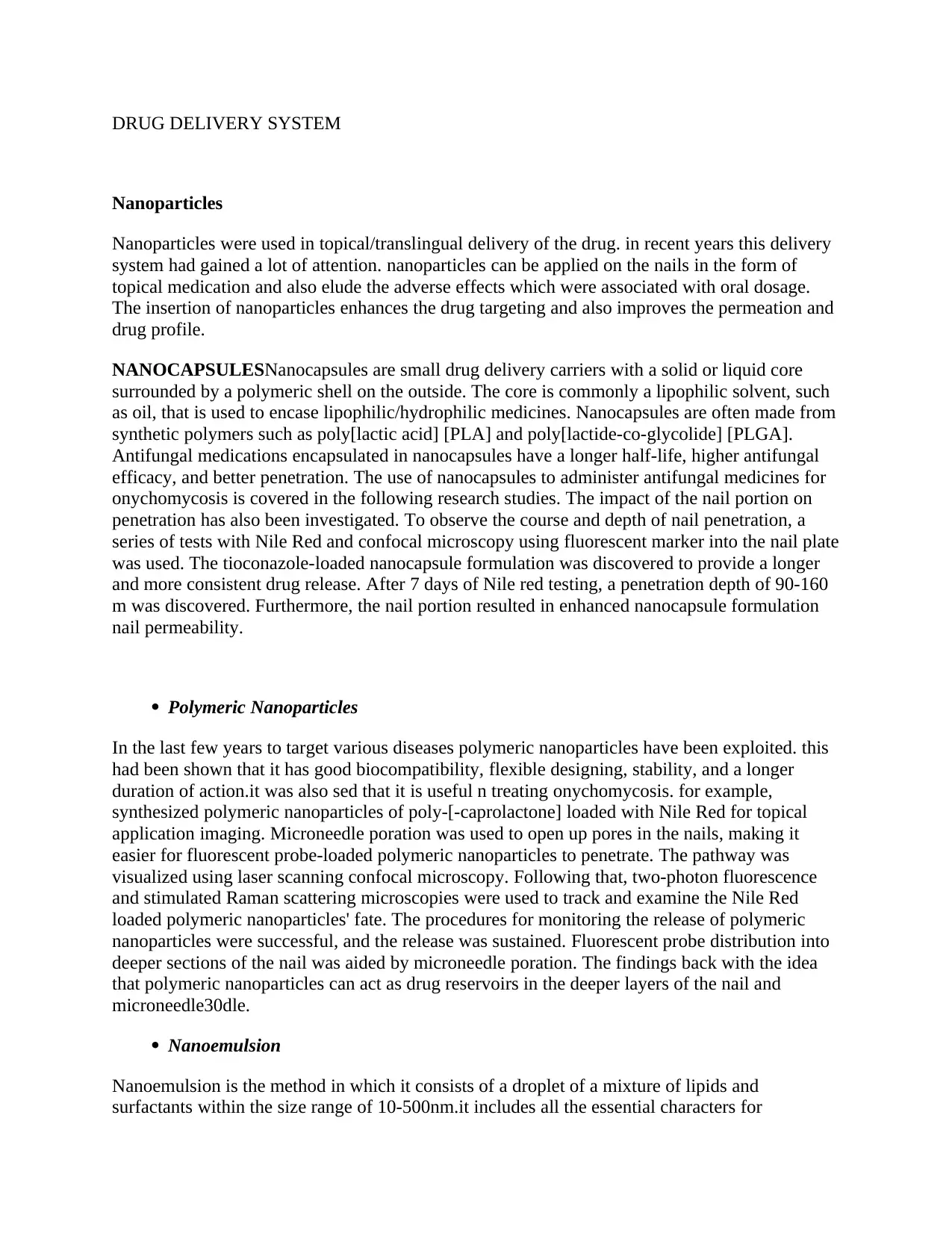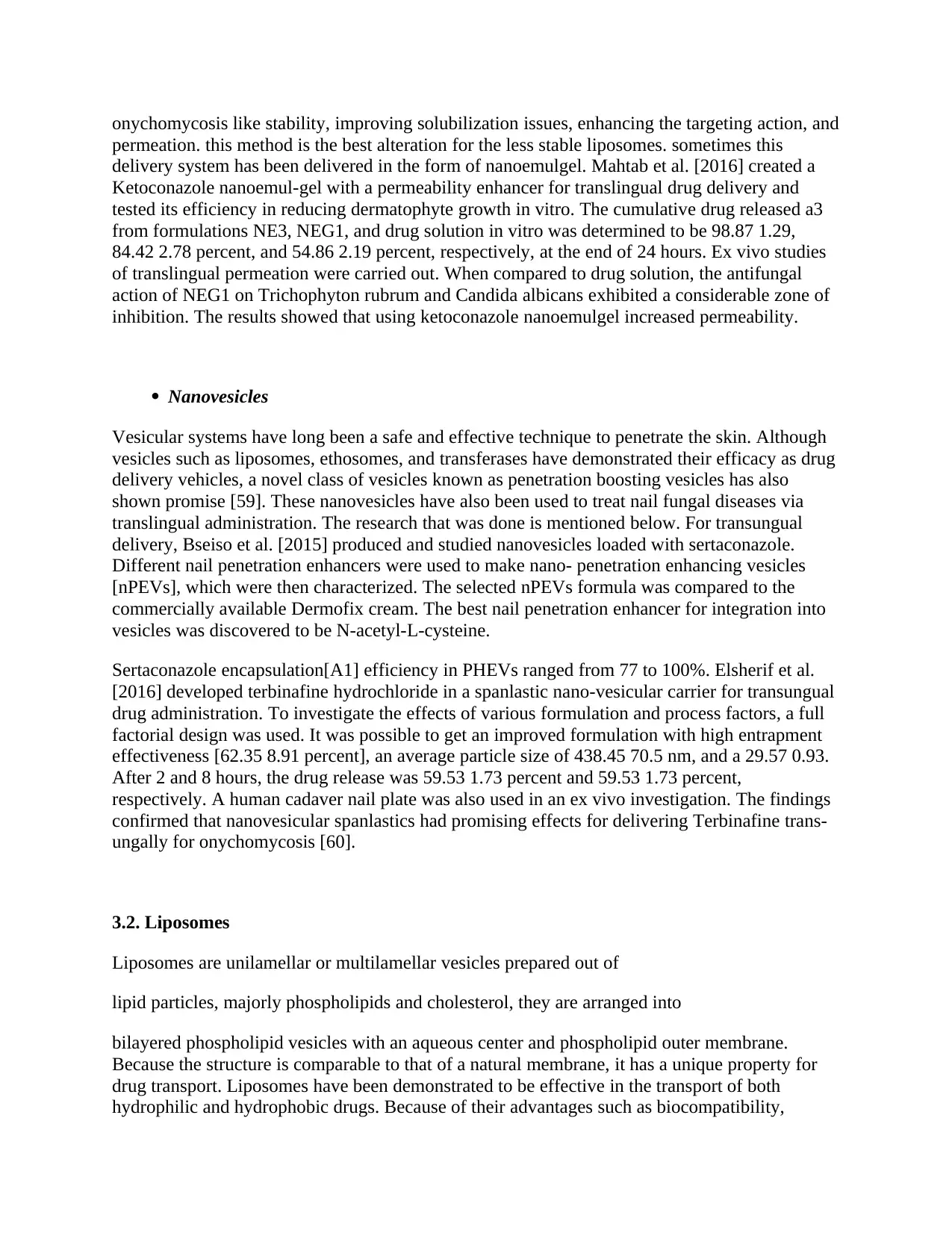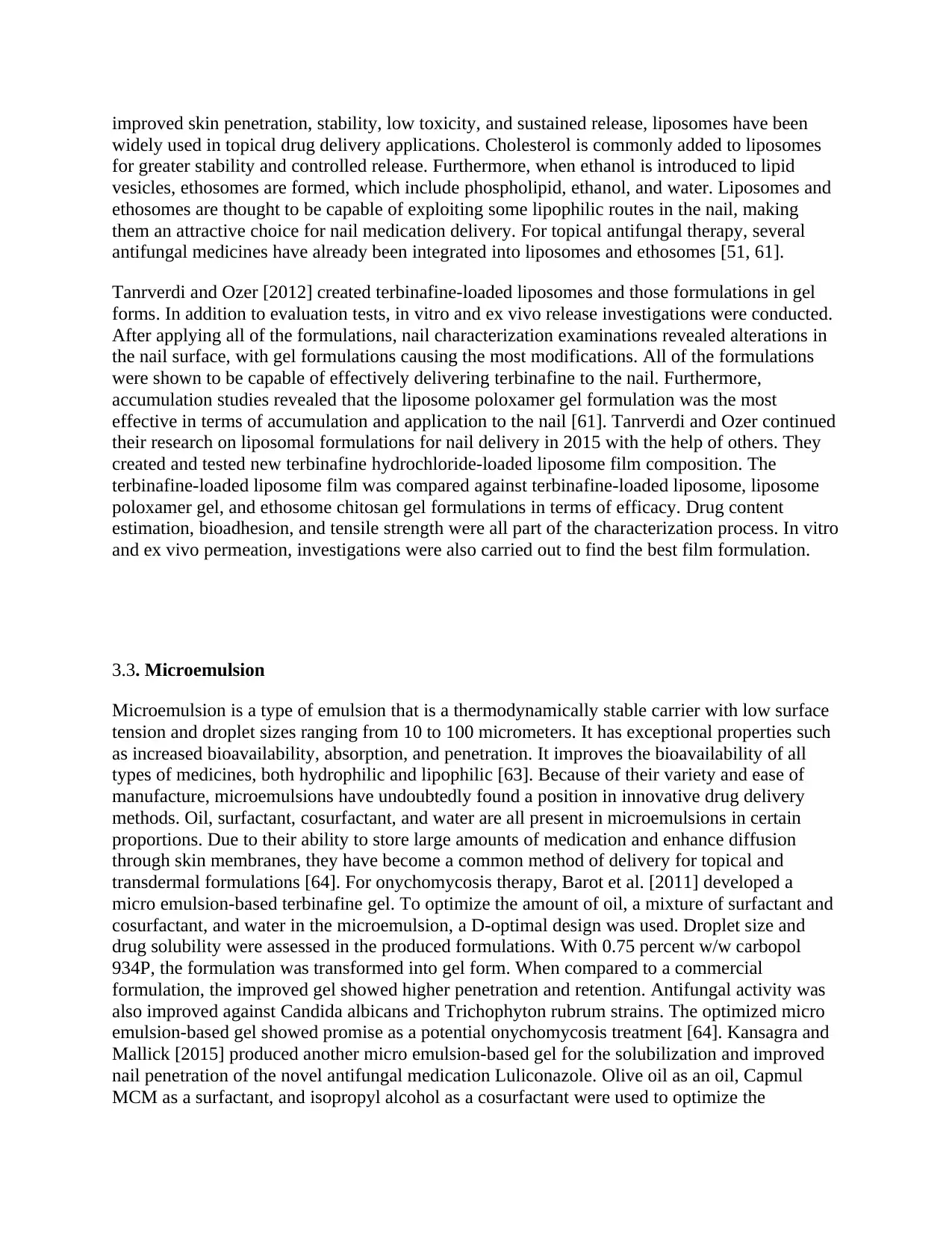Nanoparticle-Based Drug Delivery Systems for Onychomycosis Treatment
VerifiedAdded on 2022/01/25
|4
|1656
|222
Report
AI Summary
This report provides a comprehensive overview of nanoparticle-based drug delivery systems, focusing on their application in topical and translingual administration, particularly for the treatment of onychomycosis. It discusses various types of nanoparticles, including nanocapsules, polymeric nanoparticles, nanoemulsions, nanovesicles, liposomes, and microemulsions, highlighting their advantages in terms of drug targeting, permeation enhancement, and sustained release. The report examines research studies that utilize these nanoparticles to deliver antifungal medications, improve drug efficacy, and overcome challenges associated with conventional drug delivery methods. Specific examples include the use of nanocapsules for extended drug release, polymeric nanoparticles for targeted drug reservoirs, nanoemulsions for enhanced solubilization, and liposomes for improved skin penetration. The report also details the formulation and evaluation of these systems, including in vitro and ex vivo studies, demonstrating their potential as effective treatments for onychomycosis. Desklib provides access to this report and other related study materials.

DRUG DELIVERY SYSTEM
Nanoparticles
Nanoparticles were used in topical/translingual delivery of the drug. in recent years this delivery
system had gained a lot of attention. nanoparticles can be applied on the nails in the form of
topical medication and also elude the adverse effects which were associated with oral dosage.
The insertion of nanoparticles enhances the drug targeting and also improves the permeation and
drug profile.
NANOCAPSULESNanocapsules are small drug delivery carriers with a solid or liquid core
surrounded by a polymeric shell on the outside. The core is commonly a lipophilic solvent, such
as oil, that is used to encase lipophilic/hydrophilic medicines. Nanocapsules are often made from
synthetic polymers such as poly[lactic acid] [PLA] and poly[lactide-co-glycolide] [PLGA].
Antifungal medications encapsulated in nanocapsules have a longer half-life, higher antifungal
efficacy, and better penetration. The use of nanocapsules to administer antifungal medicines for
onychomycosis is covered in the following research studies. The impact of the nail portion on
penetration has also been investigated. To observe the course and depth of nail penetration, a
series of tests with Nile Red and confocal microscopy using fluorescent marker into the nail plate
was used. The tioconazole-loaded nanocapsule formulation was discovered to provide a longer
and more consistent drug release. After 7 days of Nile red testing, a penetration depth of 90-160
m was discovered. Furthermore, the nail portion resulted in enhanced nanocapsule formulation
nail permeability.
Polymeric Nanoparticles
In the last few years to target various diseases polymeric nanoparticles have been exploited. this
had been shown that it has good biocompatibility, flexible designing, stability, and a longer
duration of action.it was also sed that it is useful n treating onychomycosis. for example,
synthesized polymeric nanoparticles of poly-[-caprolactone] loaded with Nile Red for topical
application imaging. Microneedle poration was used to open up pores in the nails, making it
easier for fluorescent probe-loaded polymeric nanoparticles to penetrate. The pathway was
visualized using laser scanning confocal microscopy. Following that, two-photon fluorescence
and stimulated Raman scattering microscopies were used to track and examine the Nile Red
loaded polymeric nanoparticles' fate. The procedures for monitoring the release of polymeric
nanoparticles were successful, and the release was sustained. Fluorescent probe distribution into
deeper sections of the nail was aided by microneedle poration. The findings back with the idea
that polymeric nanoparticles can act as drug reservoirs in the deeper layers of the nail and
microneedle30dle.
Nanoemulsion
Nanoemulsion is the method in which it consists of a droplet of a mixture of lipids and
surfactants within the size range of 10-500nm.it includes all the essential characters for
Nanoparticles
Nanoparticles were used in topical/translingual delivery of the drug. in recent years this delivery
system had gained a lot of attention. nanoparticles can be applied on the nails in the form of
topical medication and also elude the adverse effects which were associated with oral dosage.
The insertion of nanoparticles enhances the drug targeting and also improves the permeation and
drug profile.
NANOCAPSULESNanocapsules are small drug delivery carriers with a solid or liquid core
surrounded by a polymeric shell on the outside. The core is commonly a lipophilic solvent, such
as oil, that is used to encase lipophilic/hydrophilic medicines. Nanocapsules are often made from
synthetic polymers such as poly[lactic acid] [PLA] and poly[lactide-co-glycolide] [PLGA].
Antifungal medications encapsulated in nanocapsules have a longer half-life, higher antifungal
efficacy, and better penetration. The use of nanocapsules to administer antifungal medicines for
onychomycosis is covered in the following research studies. The impact of the nail portion on
penetration has also been investigated. To observe the course and depth of nail penetration, a
series of tests with Nile Red and confocal microscopy using fluorescent marker into the nail plate
was used. The tioconazole-loaded nanocapsule formulation was discovered to provide a longer
and more consistent drug release. After 7 days of Nile red testing, a penetration depth of 90-160
m was discovered. Furthermore, the nail portion resulted in enhanced nanocapsule formulation
nail permeability.
Polymeric Nanoparticles
In the last few years to target various diseases polymeric nanoparticles have been exploited. this
had been shown that it has good biocompatibility, flexible designing, stability, and a longer
duration of action.it was also sed that it is useful n treating onychomycosis. for example,
synthesized polymeric nanoparticles of poly-[-caprolactone] loaded with Nile Red for topical
application imaging. Microneedle poration was used to open up pores in the nails, making it
easier for fluorescent probe-loaded polymeric nanoparticles to penetrate. The pathway was
visualized using laser scanning confocal microscopy. Following that, two-photon fluorescence
and stimulated Raman scattering microscopies were used to track and examine the Nile Red
loaded polymeric nanoparticles' fate. The procedures for monitoring the release of polymeric
nanoparticles were successful, and the release was sustained. Fluorescent probe distribution into
deeper sections of the nail was aided by microneedle poration. The findings back with the idea
that polymeric nanoparticles can act as drug reservoirs in the deeper layers of the nail and
microneedle30dle.
Nanoemulsion
Nanoemulsion is the method in which it consists of a droplet of a mixture of lipids and
surfactants within the size range of 10-500nm.it includes all the essential characters for
Paraphrase This Document
Need a fresh take? Get an instant paraphrase of this document with our AI Paraphraser

onychomycosis like stability, improving solubilization issues, enhancing the targeting action, and
permeation. this method is the best alteration for the less stable liposomes. sometimes this
delivery system has been delivered in the form of nanoemulgel. Mahtab et al. [2016] created a
Ketoconazole nanoemul-gel with a permeability enhancer for translingual drug delivery and
tested its efficiency in reducing dermatophyte growth in vitro. The cumulative drug released a3
from formulations NE3, NEG1, and drug solution in vitro was determined to be 98.87 1.29,
84.42 2.78 percent, and 54.86 2.19 percent, respectively, at the end of 24 hours. Ex vivo studies
of translingual permeation were carried out. When compared to drug solution, the antifungal
action of NEG1 on Trichophyton rubrum and Candida albicans exhibited a considerable zone of
inhibition. The results showed that using ketoconazole nanoemulgel increased permeability.
Nanovesicles
Vesicular systems have long been a safe and effective technique to penetrate the skin. Although
vesicles such as liposomes, ethosomes, and transferases have demonstrated their efficacy as drug
delivery vehicles, a novel class of vesicles known as penetration boosting vesicles has also
shown promise [59]. These nanovesicles have also been used to treat nail fungal diseases via
translingual administration. The research that was done is mentioned below. For transungual
delivery, Bseiso et al. [2015] produced and studied nanovesicles loaded with sertaconazole.
Different nail penetration enhancers were used to make nano- penetration enhancing vesicles
[nPEVs], which were then characterized. The selected nPEVs formula was compared to the
commercially available Dermofix cream. The best nail penetration enhancer for integration into
vesicles was discovered to be N-acetyl-L-cysteine.
Sertaconazole encapsulation[A1] efficiency in PHEVs ranged from 77 to 100%. Elsherif et al.
[2016] developed terbinafine hydrochloride in a spanlastic nano-vesicular carrier for transungual
drug administration. To investigate the effects of various formulation and process factors, a full
factorial design was used. It was possible to get an improved formulation with high entrapment
effectiveness [62.35 8.91 percent], an average particle size of 438.45 70.5 nm, and a 29.57 0.93.
After 2 and 8 hours, the drug release was 59.53 1.73 percent and 59.53 1.73 percent,
respectively. A human cadaver nail plate was also used in an ex vivo investigation. The findings
confirmed that nanovesicular spanlastics had promising effects for delivering Terbinafine trans-
ungally for onychomycosis [60].
3.2. Liposomes
Liposomes are unilamellar or multilamellar vesicles prepared out of
lipid particles, majorly phospholipids and cholesterol, they are arranged into
bilayered phospholipid vesicles with an aqueous center and phospholipid outer membrane.
Because the structure is comparable to that of a natural membrane, it has a unique property for
drug transport. Liposomes have been demonstrated to be effective in the transport of both
hydrophilic and hydrophobic drugs. Because of their advantages such as biocompatibility,
permeation. this method is the best alteration for the less stable liposomes. sometimes this
delivery system has been delivered in the form of nanoemulgel. Mahtab et al. [2016] created a
Ketoconazole nanoemul-gel with a permeability enhancer for translingual drug delivery and
tested its efficiency in reducing dermatophyte growth in vitro. The cumulative drug released a3
from formulations NE3, NEG1, and drug solution in vitro was determined to be 98.87 1.29,
84.42 2.78 percent, and 54.86 2.19 percent, respectively, at the end of 24 hours. Ex vivo studies
of translingual permeation were carried out. When compared to drug solution, the antifungal
action of NEG1 on Trichophyton rubrum and Candida albicans exhibited a considerable zone of
inhibition. The results showed that using ketoconazole nanoemulgel increased permeability.
Nanovesicles
Vesicular systems have long been a safe and effective technique to penetrate the skin. Although
vesicles such as liposomes, ethosomes, and transferases have demonstrated their efficacy as drug
delivery vehicles, a novel class of vesicles known as penetration boosting vesicles has also
shown promise [59]. These nanovesicles have also been used to treat nail fungal diseases via
translingual administration. The research that was done is mentioned below. For transungual
delivery, Bseiso et al. [2015] produced and studied nanovesicles loaded with sertaconazole.
Different nail penetration enhancers were used to make nano- penetration enhancing vesicles
[nPEVs], which were then characterized. The selected nPEVs formula was compared to the
commercially available Dermofix cream. The best nail penetration enhancer for integration into
vesicles was discovered to be N-acetyl-L-cysteine.
Sertaconazole encapsulation[A1] efficiency in PHEVs ranged from 77 to 100%. Elsherif et al.
[2016] developed terbinafine hydrochloride in a spanlastic nano-vesicular carrier for transungual
drug administration. To investigate the effects of various formulation and process factors, a full
factorial design was used. It was possible to get an improved formulation with high entrapment
effectiveness [62.35 8.91 percent], an average particle size of 438.45 70.5 nm, and a 29.57 0.93.
After 2 and 8 hours, the drug release was 59.53 1.73 percent and 59.53 1.73 percent,
respectively. A human cadaver nail plate was also used in an ex vivo investigation. The findings
confirmed that nanovesicular spanlastics had promising effects for delivering Terbinafine trans-
ungally for onychomycosis [60].
3.2. Liposomes
Liposomes are unilamellar or multilamellar vesicles prepared out of
lipid particles, majorly phospholipids and cholesterol, they are arranged into
bilayered phospholipid vesicles with an aqueous center and phospholipid outer membrane.
Because the structure is comparable to that of a natural membrane, it has a unique property for
drug transport. Liposomes have been demonstrated to be effective in the transport of both
hydrophilic and hydrophobic drugs. Because of their advantages such as biocompatibility,

improved skin penetration, stability, low toxicity, and sustained release, liposomes have been
widely used in topical drug delivery applications. Cholesterol is commonly added to liposomes
for greater stability and controlled release. Furthermore, when ethanol is introduced to lipid
vesicles, ethosomes are formed, which include phospholipid, ethanol, and water. Liposomes and
ethosomes are thought to be capable of exploiting some lipophilic routes in the nail, making
them an attractive choice for nail medication delivery. For topical antifungal therapy, several
antifungal medicines have already been integrated into liposomes and ethosomes [51, 61].
Tanrverdi and Ozer [2012] created terbinafine-loaded liposomes and those formulations in gel
forms. In addition to evaluation tests, in vitro and ex vivo release investigations were conducted.
After applying all of the formulations, nail characterization examinations revealed alterations in
the nail surface, with gel formulations causing the most modifications. All of the formulations
were shown to be capable of effectively delivering terbinafine to the nail. Furthermore,
accumulation studies revealed that the liposome poloxamer gel formulation was the most
effective in terms of accumulation and application to the nail [61]. Tanrverdi and Ozer continued
their research on liposomal formulations for nail delivery in 2015 with the help of others. They
created and tested new terbinafine hydrochloride-loaded liposome film composition. The
terbinafine-loaded liposome film was compared against terbinafine-loaded liposome, liposome
poloxamer gel, and ethosome chitosan gel formulations in terms of efficacy. Drug content
estimation, bioadhesion, and tensile strength were all part of the characterization process. In vitro
and ex vivo permeation, investigations were also carried out to find the best film formulation.
3.3. Microemulsion
Microemulsion is a type of emulsion that is a thermodynamically stable carrier with low surface
tension and droplet sizes ranging from 10 to 100 micrometers. It has exceptional properties such
as increased bioavailability, absorption, and penetration. It improves the bioavailability of all
types of medicines, both hydrophilic and lipophilic [63]. Because of their variety and ease of
manufacture, microemulsions have undoubtedly found a position in innovative drug delivery
methods. Oil, surfactant, cosurfactant, and water are all present in microemulsions in certain
proportions. Due to their ability to store large amounts of medication and enhance diffusion
through skin membranes, they have become a common method of delivery for topical and
transdermal formulations [64]. For onychomycosis therapy, Barot et al. [2011] developed a
micro emulsion-based terbinafine gel. To optimize the amount of oil, a mixture of surfactant and
cosurfactant, and water in the microemulsion, a D-optimal design was used. Droplet size and
drug solubility were assessed in the produced formulations. With 0.75 percent w/w carbopol
934P, the formulation was transformed into gel form. When compared to a commercial
formulation, the improved gel showed higher penetration and retention. Antifungal activity was
also improved against Candida albicans and Trichophyton rubrum strains. The optimized micro
emulsion-based gel showed promise as a potential onychomycosis treatment [64]. Kansagra and
Mallick [2015] produced another micro emulsion-based gel for the solubilization and improved
nail penetration of the novel antifungal medication Luliconazole. Olive oil as an oil, Capmul
MCM as a surfactant, and isopropyl alcohol as a cosurfactant were used to optimize the
widely used in topical drug delivery applications. Cholesterol is commonly added to liposomes
for greater stability and controlled release. Furthermore, when ethanol is introduced to lipid
vesicles, ethosomes are formed, which include phospholipid, ethanol, and water. Liposomes and
ethosomes are thought to be capable of exploiting some lipophilic routes in the nail, making
them an attractive choice for nail medication delivery. For topical antifungal therapy, several
antifungal medicines have already been integrated into liposomes and ethosomes [51, 61].
Tanrverdi and Ozer [2012] created terbinafine-loaded liposomes and those formulations in gel
forms. In addition to evaluation tests, in vitro and ex vivo release investigations were conducted.
After applying all of the formulations, nail characterization examinations revealed alterations in
the nail surface, with gel formulations causing the most modifications. All of the formulations
were shown to be capable of effectively delivering terbinafine to the nail. Furthermore,
accumulation studies revealed that the liposome poloxamer gel formulation was the most
effective in terms of accumulation and application to the nail [61]. Tanrverdi and Ozer continued
their research on liposomal formulations for nail delivery in 2015 with the help of others. They
created and tested new terbinafine hydrochloride-loaded liposome film composition. The
terbinafine-loaded liposome film was compared against terbinafine-loaded liposome, liposome
poloxamer gel, and ethosome chitosan gel formulations in terms of efficacy. Drug content
estimation, bioadhesion, and tensile strength were all part of the characterization process. In vitro
and ex vivo permeation, investigations were also carried out to find the best film formulation.
3.3. Microemulsion
Microemulsion is a type of emulsion that is a thermodynamically stable carrier with low surface
tension and droplet sizes ranging from 10 to 100 micrometers. It has exceptional properties such
as increased bioavailability, absorption, and penetration. It improves the bioavailability of all
types of medicines, both hydrophilic and lipophilic [63]. Because of their variety and ease of
manufacture, microemulsions have undoubtedly found a position in innovative drug delivery
methods. Oil, surfactant, cosurfactant, and water are all present in microemulsions in certain
proportions. Due to their ability to store large amounts of medication and enhance diffusion
through skin membranes, they have become a common method of delivery for topical and
transdermal formulations [64]. For onychomycosis therapy, Barot et al. [2011] developed a
micro emulsion-based terbinafine gel. To optimize the amount of oil, a mixture of surfactant and
cosurfactant, and water in the microemulsion, a D-optimal design was used. Droplet size and
drug solubility were assessed in the produced formulations. With 0.75 percent w/w carbopol
934P, the formulation was transformed into gel form. When compared to a commercial
formulation, the improved gel showed higher penetration and retention. Antifungal activity was
also improved against Candida albicans and Trichophyton rubrum strains. The optimized micro
emulsion-based gel showed promise as a potential onychomycosis treatment [64]. Kansagra and
Mallick [2015] produced another micro emulsion-based gel for the solubilization and improved
nail penetration of the novel antifungal medication Luliconazole. Olive oil as an oil, Capmul
MCM as a surfactant, and isopropyl alcohol as a cosurfactant were used to optimize the
⊘ This is a preview!⊘
Do you want full access?
Subscribe today to unlock all pages.

Trusted by 1+ million students worldwide

microemulsion. Particle size analysis, droplet size, spreadability, stability, and in vitro release
investigations were all performed as part of the evaluation process. The optimum batch's globule
size was 32.59 nm. The micro emulsion-based gel showed antifungal activity against Candida
albicans, confirming its usefulness as an onychomycosis formulation
[A1]
investigations were all performed as part of the evaluation process. The optimum batch's globule
size was 32.59 nm. The micro emulsion-based gel showed antifungal activity against Candida
albicans, confirming its usefulness as an onychomycosis formulation
[A1]
1 out of 4
Your All-in-One AI-Powered Toolkit for Academic Success.
+13062052269
info@desklib.com
Available 24*7 on WhatsApp / Email
![[object Object]](/_next/static/media/star-bottom.7253800d.svg)
Unlock your academic potential
Copyright © 2020–2025 A2Z Services. All Rights Reserved. Developed and managed by ZUCOL.